The BMW G 310 GS; Taking on Vietnam’s Challenging Terrain – Onyabike
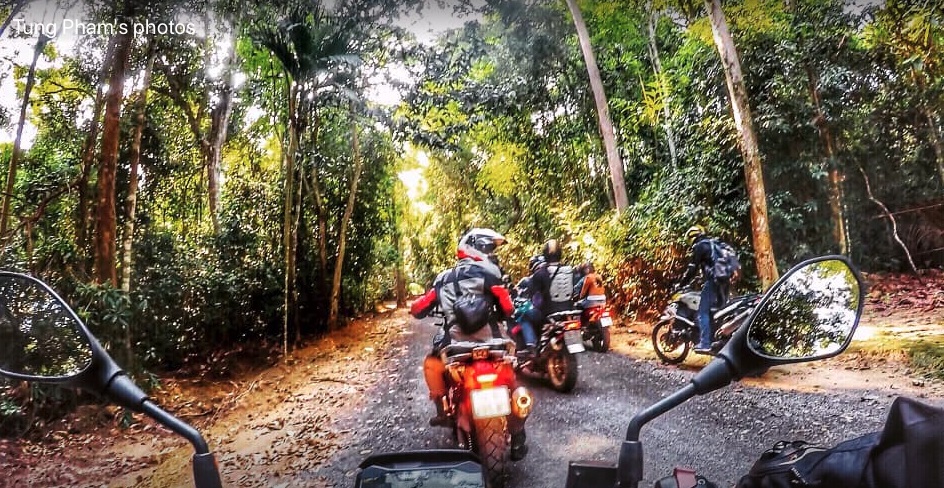
In November 2015, BMW treated the press to a glimpse of a prototype BMW G 310 GS. The bike specifically designed to attack a whole new adventure rider market caused quite a stir.
The company hadn’t produced a small-bore single cylinder motorbike for over 50 years and packing the GS badge; the BMW G 310 GS had a lot to live up to, to exceed or even meet expectations.
Aimed first at the Indian subcontinent, buyers had to wait until 2018 for the BMW G 310 GS to hit the showroom floor in Vietnam. Although a new target audience for BMW, the small-bore adventure rider marketplace already had plenty on offer.
The Kawasaki Versys 300, Honda’s CRF250, and 450L’s, Yamaha XTZ 250, even the Royal Enfield Himalayan, all beat BMW to the punch.
Has this major manufacturer done enough with the BMW G 310 GS to carve themselves a piece of the small-bore adventure rider action? What’s more, can this model cope with the challenging terrain in Vietnam back roads?
Finally, how does the BMW G 310 GS fare as a bike capable of tackling a Vietnam motorbike tour? To answer these questions and more, let’s take a closer look.
BMW G 310 GS: Model History
Strictly speaking, BM’s road-going BMW G 310 R was first on the scene and hailed by BM at the time as the essence of riding pleasure.
The BMW G 310 R, with its reduced capacity 313 cc engine, offered a lightweight, easy to handle and maneuverable small bike for both small and tall.
Equally, at home on the commute to work in the city or a weekend blast away from it, the BMW G 310 R gave good, sporty value for money.
Within weeks of its launch, however, the much-awaited BMW G 310 GS made its debut and stole the limelight.
Same Same But Different
The BMW G 310 GS and BMW G 310 R share the same frame, engine, and brakes, with obvious changes to the GS’s suspension. That’s not the only difference between the two, though.
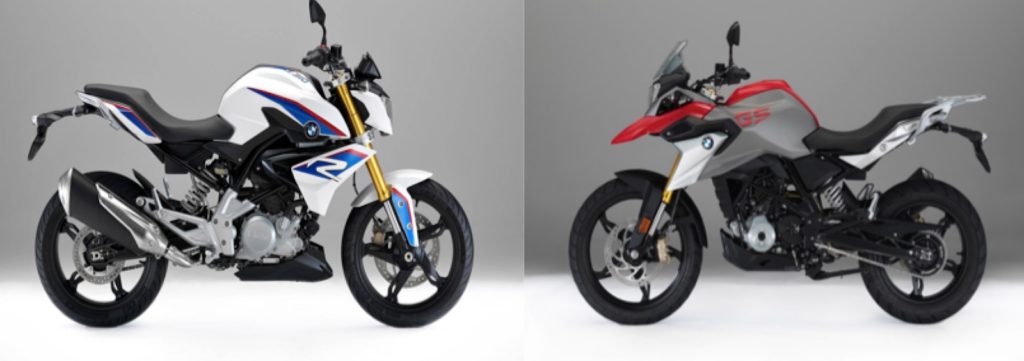
As you’d expect, the BMW G 310 GS gets an extra 40mm of wheelbase over the BMW G 310 R. Width is up to 60mm, there’s 40mm of additional suspension travel and a much-needed 55mm of added ground clearance.
Seat height is 835mm, but interestingly, the BMW G 310 GS gains an additional 11kgs of weight. The engines in both bikes pump out the same 34 horses and drive through a 6-speed box.
Seeing Double!
The more eagle-eyed of you may have also noted an uncanny similarity between the new BMs and a particular Indian built bike, the TVS Apache.
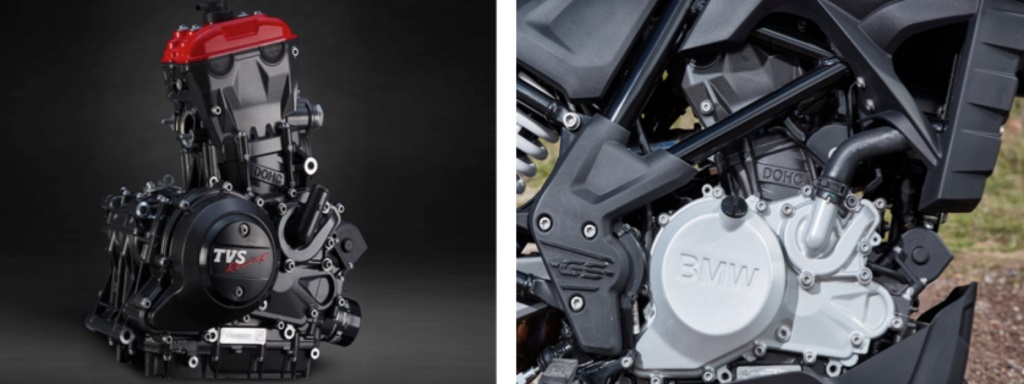
Ok, the irony of an Indian made bike called an Apache isn’t lost, but at least it’s not like blatant Chinese knock-offs such as ‘Homda’ and ‘Keweseki’.
Of more importance, though, not only is BMW aware of, but they’ve encouraged the similarities. The new BMW G310 range is a collaboration between the German giant and TVS, India’s third-largest motorcycle builder.
Made in India, it made sense to launch it locally first, but the baby BMW G 310 GS is now available to an international market, which includes Western Europe and the USA.
Unlike much of its Japanese opposition, the BMW G 310 GS is officially available in Vietnam, alongside perhaps its biggest rival, the Royal Enfield Himalayan. ( Click here to read a full breakdown of the Himalayan’s capabilities).
BMW G 310 GS: Engine
With the plethora of bikes for adventure riders now on the market, you can choose from one, two, three, or even four-cylinder power plants. At this present time, though, the BMW G 310 GS is the only bike for adventure riders with double-overhead cams and a reversed cylinder head.
So what’s the deal with a reversed head I hear you ask, is it a gimmick to make it stand out from the crowd, or is there a point to its design?
The basic principle is simple. When on the move, air rams into the forward-facing Bosch injector. The higher volumetric pressure of air means you can increase the amount of fuel.
Throw in some larger valves, a high compression piston, and you can suck, explode and blow a lot faster. Voila, more bang for your buck.
In the BMW G 310 GS’s case, they’ve used four valves in the head, a compression ratio of 10.6:1 and gone a step further by angling the head backward. This design allows the exhaust pipe and therefore the gasses, to have a less restricted escape route.
BMW G 310 GS: Horsepower Versus Torque
What’s interesting here is that although BMW quote an impressive 34 hp, it comes at a whopping 9500 rpm. The maximum torque of 28Nm is not far below at 7500 rpm.
To offer a comparison: the Himalayan engine may produce a lot less at 24.5 hp, but it comes much lower at 6500 rpm. The lifeblood of any bike for the adventure rider though is torque. In this case, the Himalayan’s is an impressive 32Nm and is available right where you need it at a low-down 4250-rpm.
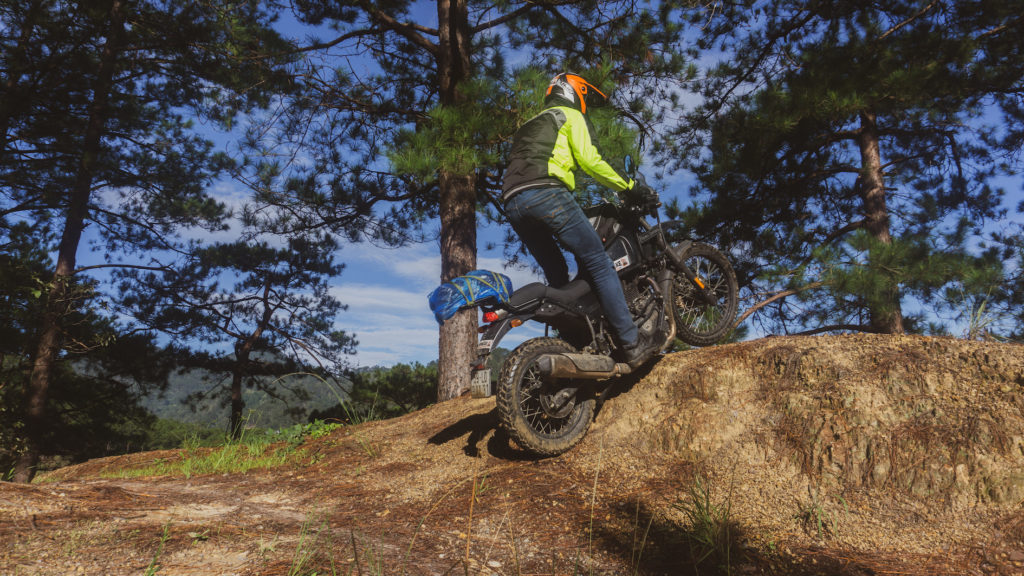
So what does this mean for the BMW G 310 GS in real terms and when thrown into a Vietnam motorbike tour scenario, with its demanding roads and challenging landscape?
As impressive as the BMW G 310 GS’ horsepower and torque figures are, they come too far up the rev range for this type of terrain.
The power delivery is more tarmac biased. A fact reinforced when you look at its road-going sibling, the BMW G 310R, which has the exact same performance/output figures.
As for top speed, a quoted 144 kph is awesome for a 310cc bike. Is it overkill on Vietnam’s uneven, traffic, animal, and pedestrian clogged roads? In reality, I have to say, yes.
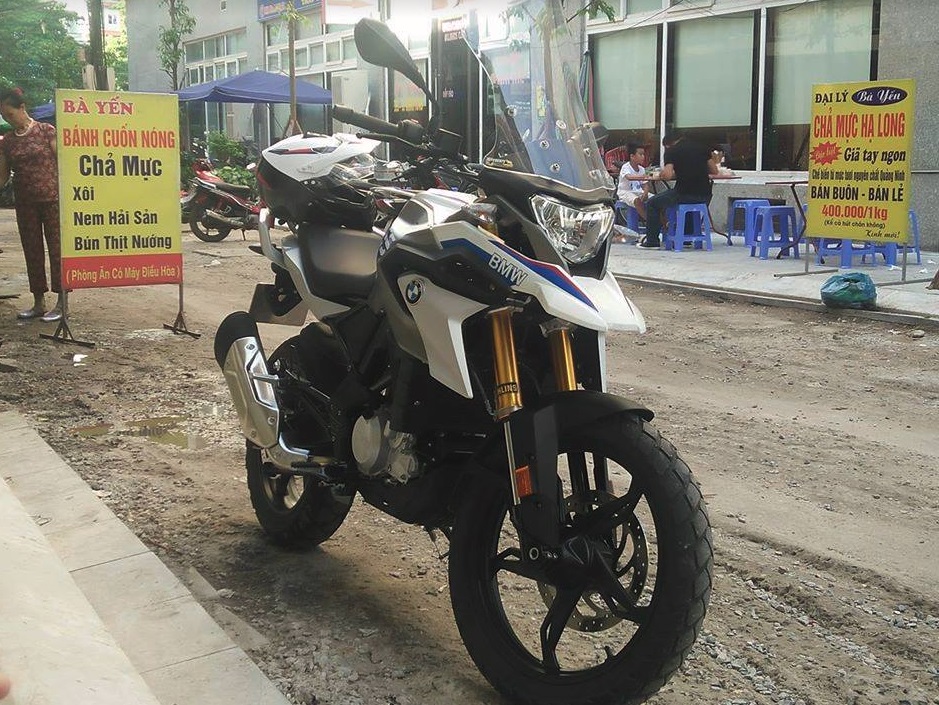
Performance aside, there are plus points to the cleverly designed engine on the BMW G 310 GS. By reversing the head, it means that the position of the radiator can be closer to the engine, making everything more compact.
Also, being able to run the exhaust out the back means that heat gets taken away from the rider’s leg. There is no risk of the pipe being damaged by locating under the bike.
BMW G 310 GS: Frame
The BMW G 310 GS uses a steel trellis backbone-type, tubular frame making the engine a stressed member. This sort of construction uses the rigidity of the engine cases to act as part of the frame.
All you adventure riders out there may be thinking that leaving the bottom of the engine unprotected by conventional frame rails is a bit dodgy. There are a few things to consider here, though.
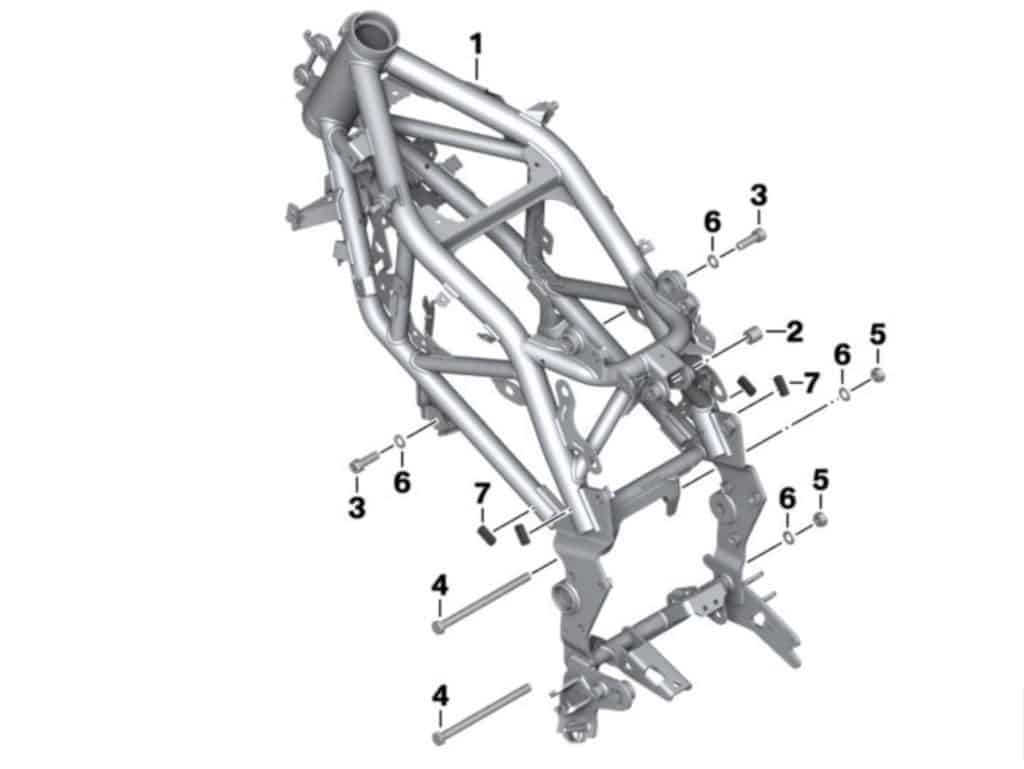
First, the weight and limited off-road ability of the BMW G 310 GS means that it shouldn’t come in for a severe bashing. Second, no lower frame offers the chance of higher ground clearance.
Last but not least, the KTM 1250 Super Adventure, BMW 1250 GS and Triumph 1200 Explorer, all use this type of frame design. They all also have steel bash plates, which brings me to my next point.
BMW G 310 GS: Lightweight Bash Plate
The BMW G 310 GS is a budget model. So it should come as no surprise that the plate protecting the underneath of the engine is flexible plastic. The unit is bolted in place via rubber bushes and appears to offer protection from flying stones, but not much else.
An aftermarket steel option would be high on any adventure rider’s shopping list, especially as right behind it is the oil filter.
Holding things up at the rear is a bolted-on tubular steel sub-frame. On the subject of bolts, the BMW G 310 GS uses metric Allen Bolts rather than the standard Torx fasteners as fitted to the rest of the BM range.
Viewing the BMW G 310 GS side-on, especially from the drive chain side, the cast and braced aluminium swingarm looks long enough to be on a hill-climber.
It’s more or an optical illusion, though, due to that section of the bike being clutter-free.
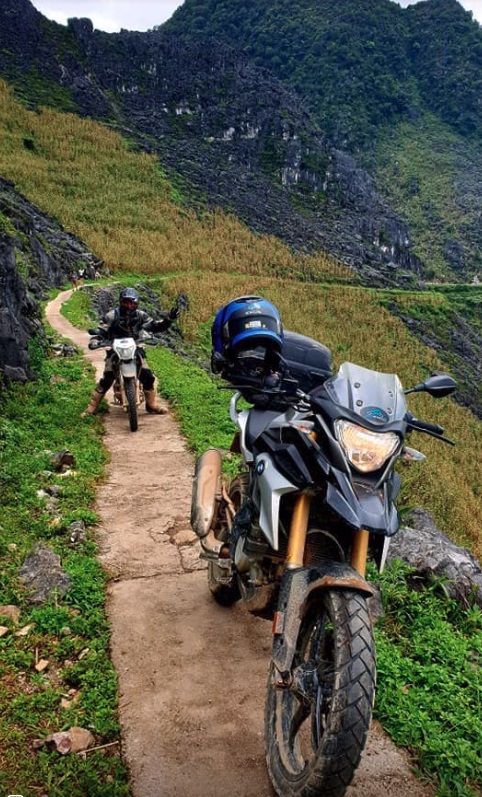
BMW G 310 GS: Bodywork
The design of the BMW G 310 GS mirrors the look of its range-topping stablemate, the R1250GS. The baby BM gets the trademark beak and intricate tank/fairing/spoiler panels. It’s here that the BMW G 310 GS’ user-friendliness comes into question.
You may have to remove the petrol tank to change the spark plug, but be thankful you don’t have to take it off to access the air filter. You’ll find the filter located just forward of the tank, but you do have to remove all the paneling to reach it.
This job is not inconsiderable, consisting of taking off at least five panels and 19 bolts.
There are no side panels on the BMW G 310 GS to speak of, leaving slim rear bodywork to cover the sub-frame, which blends nicely into a luggage rack with built-in pillion grab rails.
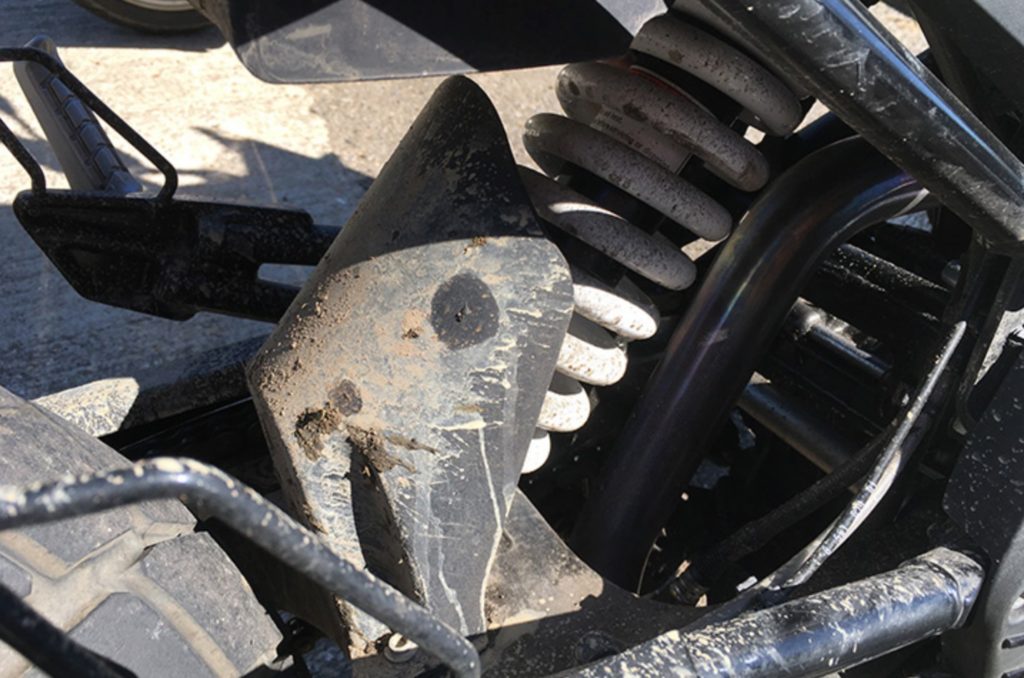
Wheels, Brakes, and Suspension
Two small panels held on by a single bolt, give access to the mono-shock and rear brake reservoir. The shock is adjustable via C spanner, for pre-load only, and comes as standard in the bike’s tool kit.
Upfront, the softly sprung 41mm upside-down KYB forks are non-adjustable. Once again, using a 110/80×19 front wheel does hint at the BMW G 310 GS’ road bias, which couples with a 150/70×17 on the rear.
The BMW G 310 GS gets single disks with a 300mm four-piston caliper on the front and 240mm twin-piston on the rear. Both discs come with ABS, which, rather splendidly, can be switched on and off on the fly.
Quick View Comparison
Weight
Seat height
Horse power
Torque
Price
BMWG 310 GS
374 lbs
32.9 inches
34 @ 9500 rpm
28 @7500 rpm
219m VND
Royal Enfield Himalayan
421 lbs
31.5 inches
24.5 @ 6500 rpm
32 @ 4250 rpm
131m VND
On the Road
With peak power from the DOHC 331cc, liquid-cooled engine coming in at 9500 rpm, to be at its best, the BMW G 310 GS needs hard revving.
Fitted with a balance shaft on the crank, handlebar and footrest buzz is kept at bay until the upper reaches of the rev range. A light clutch action and slick, six-speed box make the bike more than easy to spin.
The BMW G 310 GS’ suspension is pretty impressive on the road. The bike feels light, yet stable and very flickable. Like all adventure bikes, the front forks always nose-dive under heavy braking, and with 180mm of travel, these are no different. They soak up bumps with ease, though.
The rear suspension also gets 180mm of travel and follows the same pattern, being on the soft side. Thanks to the pre-load, you can at least jack it up to handle pillion duties.
Encounter any lumps and bumps on the road mid-bend (and on a Vietnam motorbike tour you’re going to experience plenty, check out this link and see for yourself), and the BMW G 310 GS is quick to settle back down.
Impressive Lean Angles
The off the road orientated footrest placement, and ground clearance also lets you hit some impressive lean angles too. Throw some decent road tyres on it, and you’d have a pretty reasonable super-moto.
At 835mm (a fraction under 33 inches), the saddle height seems quite high, but thanks to the narrow frame and seat/tank combo, flat-footing is very easy.
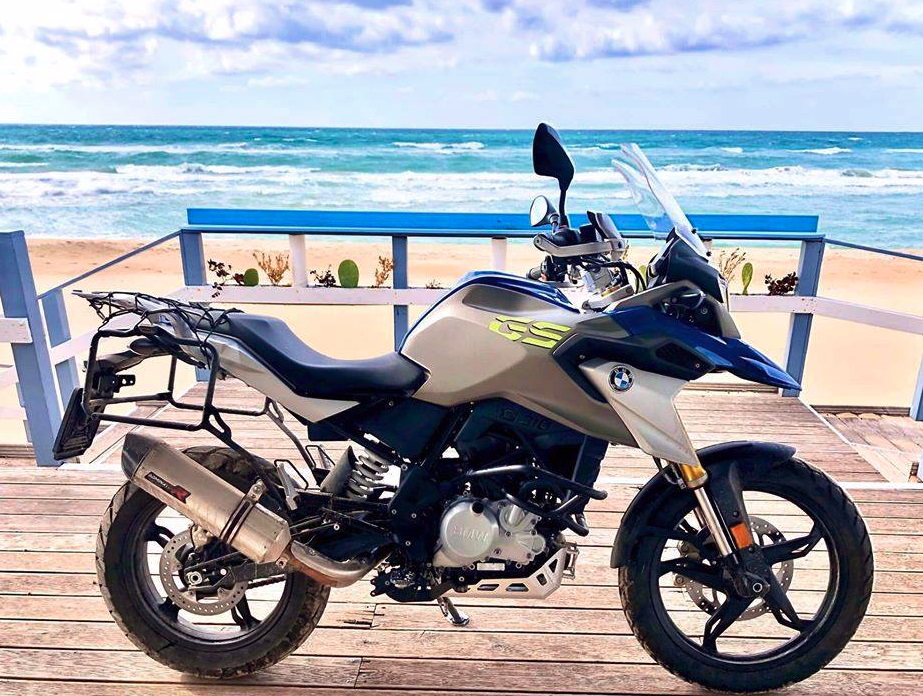
There is a step up to the pillion section, but the seat is a single contoured shape making it easy to move around on. The seat, footrest, handlebar ergonomics are good, meaning riding over distance is also comfortable.
Thanks to the position and low rise to the handlebars, you do feel with the BMW G 310 GS that you’re tilted slightly more forward than is usual on other adventure bikes.
On the road, and during a Vietnam motorbike tour, this is a plus. Not only does it make bend swinging feel very natural and controllable, but it also gives the small screen a chance to divert air over the rider’s head.
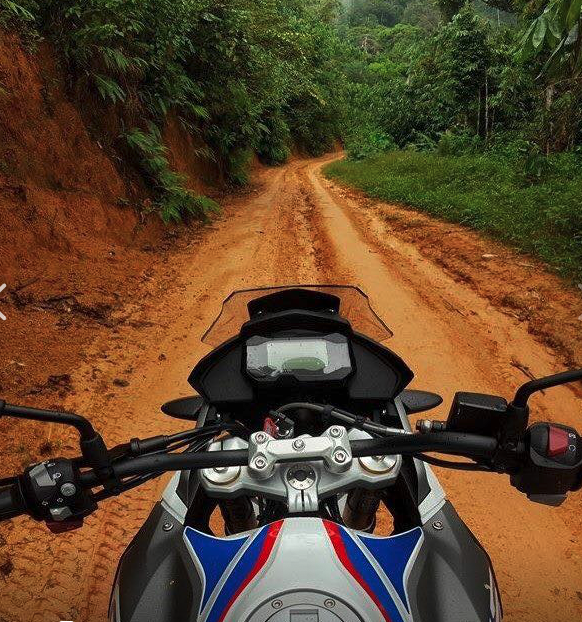
Mono LCD digital information centre lives behind a small screen
Pic – Hung Trantien BMW Motorrad Sala Vietnam
Talking of the screen, it protects the bike’s LCD instrument panel. The mono display is horizontally mounted, making it look like a large smartphone in a holder.
The digital display is straightforward. What’s more, the centrally displayed, numeric speed is easy to read. The rpm is on a bar graph along the bottom. The fuel gauge is to the left, and the gear indicator on the right. Idiot lights are in the blacked-out areas on each side.
On the Dirt
The BMW G 310 GS may share styling cues from its class dominating big brother, R1250 GS, but when it comes to heading off-road, that’s where the similarity ends.
Don’t get me wrong, fire trails and dirt tracks are no problem, the soft suspension soaks up the bumps and keeps things manageable.
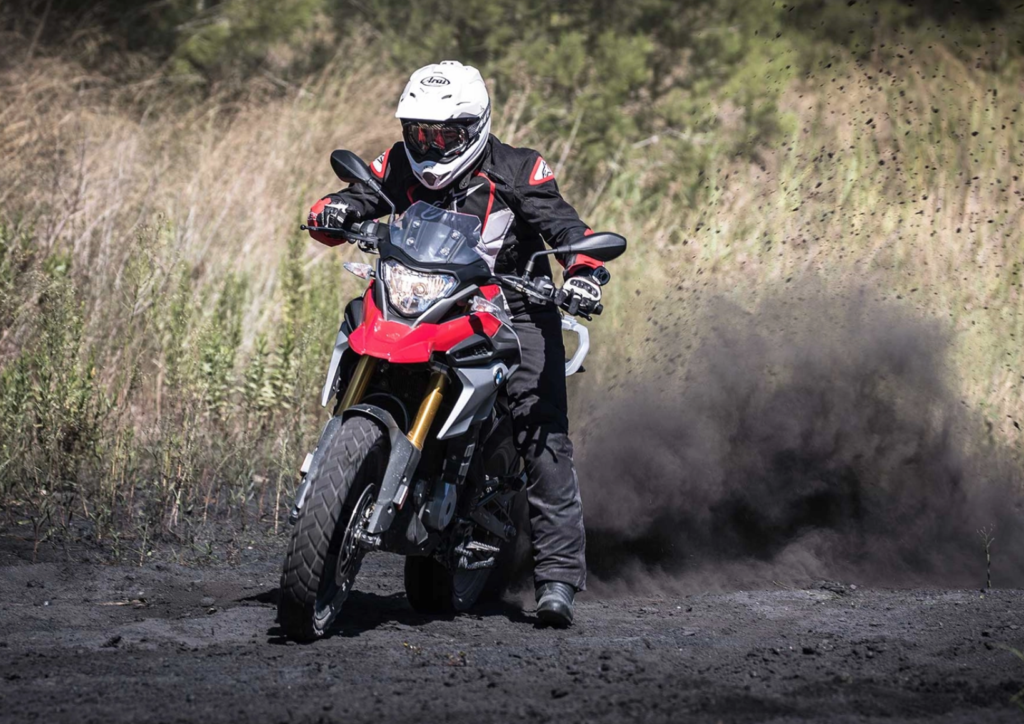
On the right type of terrain, the BMW G 310 GS would be right at home
Pic: motorcyclenews.com
Start hitting anything lumpier, and the suspension can’t cope. But then, why would you be asking anything more of it than some basic off-road stuff? It’s not what the BMW G 310 GS is for at the end of the day.
The handlebars that take the neck ache out of highway riding, now feel a bit too low. Especially when standing on the pegs as they make you lean a little bit too far forward.
BMW G 310 GS: Light Clutch Smooth Box
The light clutch action and smooth gearbox are always welcome regardless of what’s flying by under your wheels. On the type of trails and tracks that make up Vietnam’s off-road terrain, though, that revy engine is a bit more of a liability.
Add slippery or muddy conditions into the mix (another regular occurrence in Vietnam, especially for anyone on a motorbike tour), and the need for a quick hit of torque at low revs become apparent.
The BMW G 310 GS’ 28 Nm of torque appearing so high up the rev range (7500 rpm) makes riding more challenging.
Once again, this isn’t necessarily bad, rather more a case of a ‘horses for courses’ type of deal. Compacted dirt roads with a light dusting of debris, like firebreaks and farm trails, are its ideal habitat.
Here, you’d be able to take full advantage of the BMW G 310 GS’ rev hungry engine and effortlessly make good progress (which is police speak for nailing it).
On this type of terrain, you would also be able to get the best out of one of the top features on the GS. Namely, the ability to turn the ABS on and off while on the fly. For any bike with off-road aspirations, this is a big advantage.
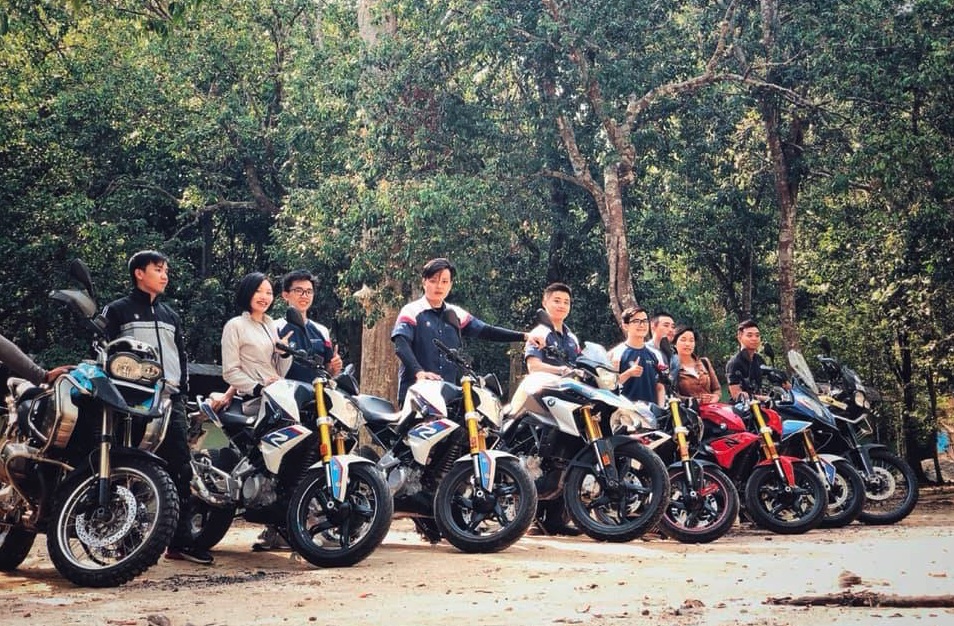
What’s the Bottom Line?
So what’s the bottom line, Is the BMW G 310 GS suitable for Vietnam and in particular, a Motorbike Tour in the country?
After putting BM’s diminutive GS under the microscope and examining its positive and negative points, it comes down to one question, can the BMW G 310 GS cut it in Vietnam?
Usually, this produces an equal list of pros and cons, making it challenging to deliver a definitive answer. In the case of the BMW G 310 GS, though, one outweighs the other.
In the BMW G 310 GS, we have a small, lightweight bike that handles great on the road and enjoys being wound up through the gears. It has impressive top speed and a genuine ability to cruise at 120 kph.
All of which are unfortunately surplus to requirements and a slight overkill on the mostly unmade, chaotic roads of Vietnam.
Take to the dirt and give it a handful while trundling through the mud, and it takes a lot more concentration to be in just the right gear. Get it wrong, and that zappy engine will get bogged down instead of instantaneously heaving you out of trouble at the twist of a wrist.
For these basic reasons, this makes the BMW G 310 GS ultimately more suitable for those countries whose highways and byways allow for more spirited riding.
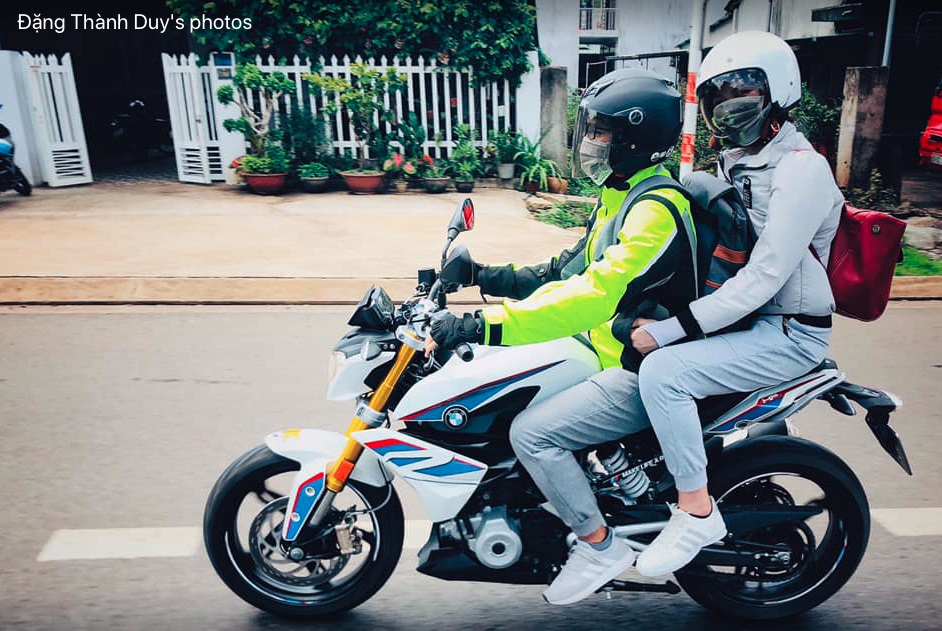
BMW G 310 GS: Staying in Control
In certain conditions, the bike is hugely capable, making riding, fast, and fun. Yet, it remains entirely controllable, which is how it should be for any adventure rider.
The BMW G 310 GS is beginner-friendly, comes with plenty of refinements, and its decent performance will keep you interested long after you’ve ditched your training wheels.
Proud BMW G310 GS owner and all-round BM fan, Tran Quoc Bao, although more than happy with his bike, is realistic about its ability. Being a resident of Ho Chi Minh City, his every day need is for a bike that is nimble, highly maneuverable and able to keep ahead of the traffic. The bike also has to handle his occasional weekend adventures in the countryside. Tran confirms that the BMW G 310 GS fits the bill perfectly.
A member of the ever-growing BMW G310 Vietnam Club, that caters for both 310 R and 310 GS models Tran says ‘’the little GS is best for city commuting, but you can combine adventure and a bit offroad.”
For tarmac and trails, this could well be the bike for you. Join the sort of Vietnam motorbike tour that takes in muddy jungle tracks, river crossings, and unmade back roads, though, and you’re going to need a different tool.
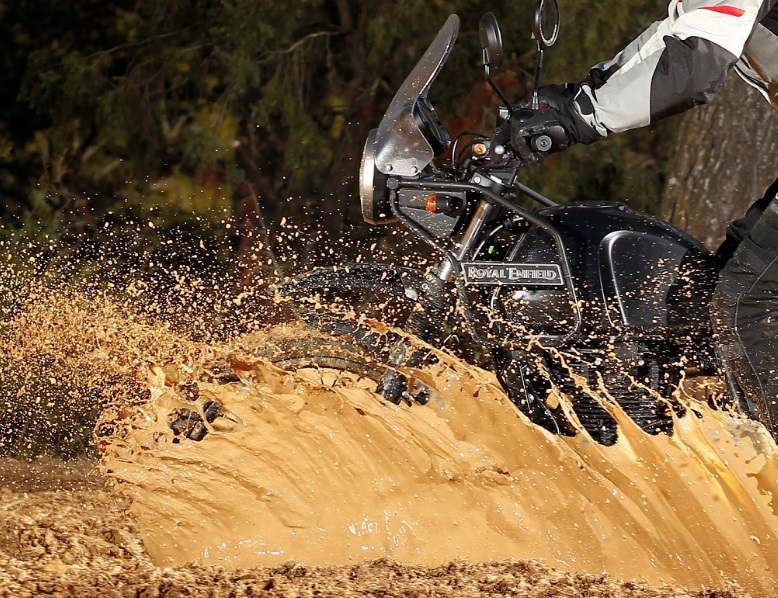
As I mentioned at the outset, this is BMW’s first step into the small capacity bike market for over half a century. The company completely rocks the big-bore adventure market, and there is no way they’d put their name on the line with an inferior product, especially one sporting the prestigious GS badge.
Onyabike Adventures take on the BMW G 310 GS
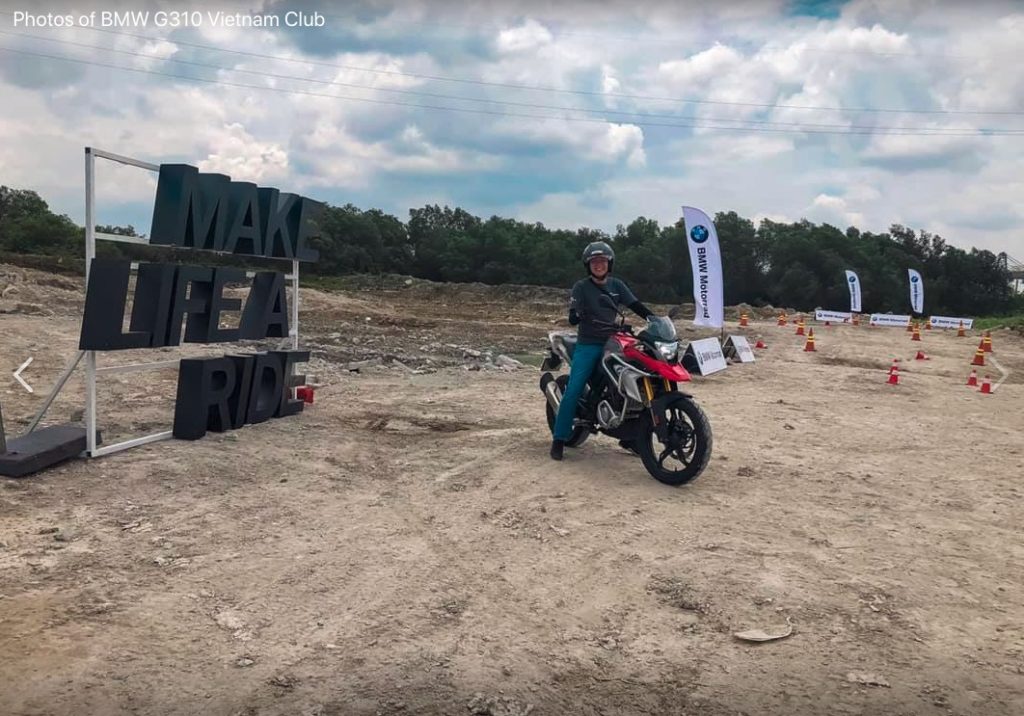
Adventure riders will buy the BMW G 310 GS on the name and looks alone; the brand demands that much respect. On paper, and on the road, the bike is very impressive, and in the right circumstances, it is hard to beat.
There is a sizeable, but and that but is the price; the BMW G310GS arrives on Vietnam’s showroom floor at a whopping 219 million VND. To put that into perspective, the Royal Enfield Himalayan comes in at 131 million VND.
Here at Onyabike Adventures, faced with having to make more real-world choices such as off-road usability and price point, we didn’t have to look very far for an alternative. The Royal Enfield Himalayan production line is in the very same Indian state capital (Chennai). As polished and performance-oriented as the BMW G310 GS undoubtedly is, very shortly, the arrival of the eagerly awaited KTM 390 Adventure will put the cat amongst the pigeons.
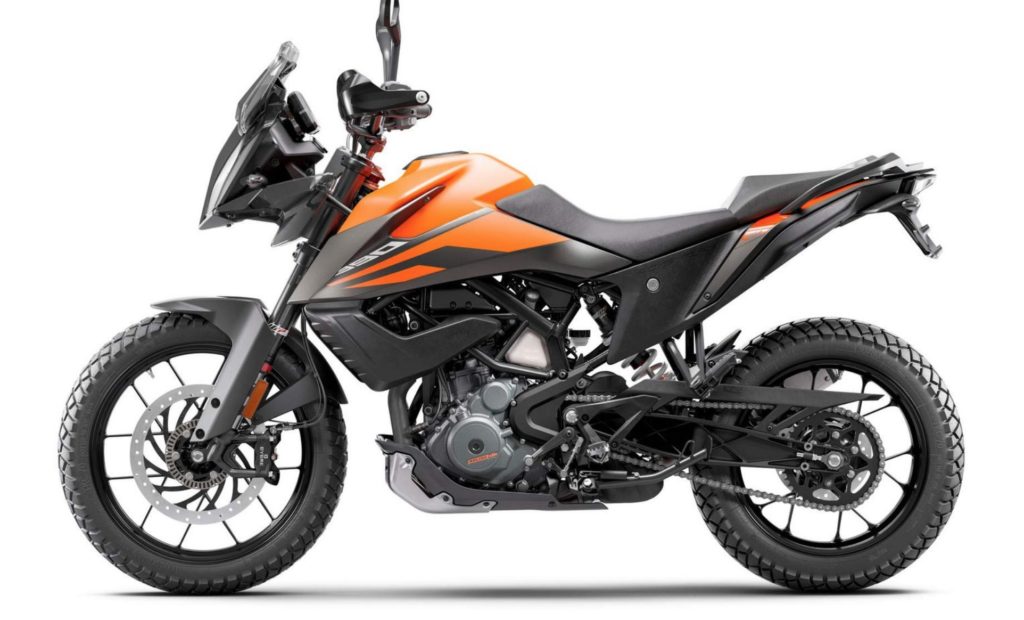
Just like the rest of its current rivals in this capacity sector, the KTM has a fuel-injected, single-cylinder engine. One look at the spec sheet though and with adjustable white Power suspension front and back, race-proven chassis, and high standard of equipment, the KTM is going to be the one to beat.
Although KTM already has an official presence in Vietnam, like BMW, import tax is seriously hefty. No official price has been quoted yet for its 2020 Vietnam launch. However, here at Onyabike Adventures we’ve made an educated guess and say between 225 – 230 million VND.
That is one serious chunk of change, even making the 219m BMW G 310 GS look good value. Could it seriously be worth 1.75 Royal Enfield Himalayans, and more importantly, will it be total overkill for adventure riders on a motorbike tour of Vietnam? I guess we at Onyabike Adventures, like everyone else, will just have to wait and see.






